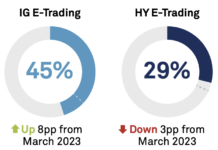
Broker dealer TP ICAP has agreed to buy block-trading market operator Liquidnet, with Nicolas Breteau, CEO of TP ICAP, putting the growth of Liquidnet’s fixed income business front and centre in the deal.
In a presentation to investors and analysts on 9 October 2020, he crucially supported continuation of the platform’s client-to-client trading model and its new primary market offering, both points of concern amongst buy-side traders when the deal was first announced. He was also careful to stress that the existing relationship between the platform and buy-side clients was firmly based on trust, a point that will not be lost on asset managers who have previously seen service providers acquired without similar care being given.
“An excellent example of both trust and innovation is its Blotter Sync technology,” he said. “With Blotter Sync Liquidnet directly accesses the buy side trader’s blotter, pulling orders into its liquidity pools, rather than the trader having to take an active decision to trade. So it’s fair to say that Liquidnet has a privileged insight into its client’s blotters.”
Liquidnet has consistently been the fourth largest corporate bond market operator in The DESK’s ‘Trading Intentions Survey’ which measures buy-side users of electronic trading platforms. TP ICAP wants to expand the platform’s capabilities in the dealer-to-client (D2C) space, stepping into the ring with Bloomberg, MarketAxess and Tradeweb.
“One of our areas of immediate focus will be to build up a market leading dealer-to-client offering,” said Breteau. “Dealers now hold much less inventory than they used to a decade ago and they do not provide immediate pricing like they used to, as a consequence of that. It doesn’t mean that the trading has declined, because it has not. But it means that the search costs have increased for the buy side.”
This has pushed buy side traders toward electronic platforms as a way of improving search efficiency, and to help them document that process and demonstrate best execution, he said. Bringing the two businesses together not only TP ICAP has strong sell-side relationships and data assets, which will be complimented by Liquidnet’s assets.
“Liquidnet brings 500 clients already connected, they bring the algo portal and blotter sync technology,” he noted. “Together we are confident in our ability to add value to the existing market structure.”
In the presentation, Breteau emphasised that onboarding buy-side firms was a notable barrier to entry for new offerings in the fixed income space.
“Many do not want to be the first, [growing connectivity] organically is hard, it’s expensive and it’s slow to achieve integration with order management systems (OMSs) and execution management systems (EMSs), which the buy side needs to trade. It’s much more efficient to build on existing technology, and to leverage existing industry partnerships and extend existing customer relationships, than to start from scratch.”]
Further opportunities for growth exist in the rates space, in which TP ICAP has a strong presence as an interdealer broker, and expects to expand in the electronic dealer-to-client arena.
“Electronic growth is strong, [but] we believe the current market structure is not ideal for many participants, because many want to have more choice,” he said.
With its interdealer rates franchise, ISWAP interest rate swaps trading platform, and Liquidnet’s client network and buy-side technology integration, Breteau asserted, “These are the ingredients for a compelling dealer-to-client interest rate platform.”
Both TP ICAP and Liquidnet offer data and analytics to support traders pre-trade and post-trade, and the combined group is expected to continue to deliver these via its expanded distribution capabilities.
“We can apply Liquidnet’s data science tools to TP ICAP’s offering to create new products and services,” Breteau said.
The deal values Liquidnet at between US$575 million and US$700 million – depending upon contingencies – and is expected to complete in Q1 2021.
©TheDESK 2020
TOP OF PAGE

























